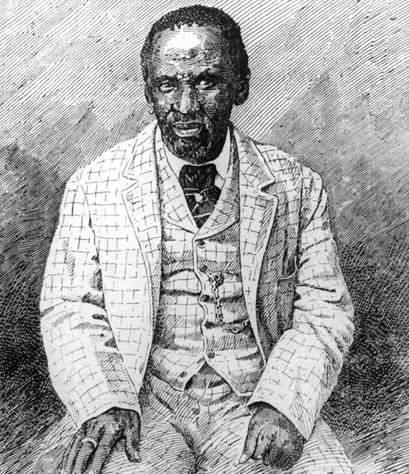Today in Kimberley's History
|
|
|
|
|
The Battle of Takoon (Dithakong) - 1878
Luka Jantjie was born in Kimberley in 1835 and was the son of a Christian convert. He was the cousin of Kgosi Galeshewe. Later he became Kgosi (Chief) Luka Jantjie, a hunter, trader, diamond prospector, and farmer. He was a chief of the Batlhaping ba Manyeding group of the Batswana in Kuruman. When diamonds were discovered in Kimberley in 1871, diamond diggers swarmed onto Jantjie's land in search of diamonds and took it over. Jantjie and his people were the first local people whose ancestral land was stolen from them due to diamond prospecting by colonists. Jantjie was outspoken against the land invasion, however, he initially took a non-violent approach towards the British which included boycotting the rural trading stores. In addition, Jantjie fought for his people to attain equal rights to purchase diamond licenses so that they could share in the wealth that was being excavated on their land. However, the government of the Cape Colony refused to grant mining rights to native groups. Jantjie took up arms in response and orchestrated skirmishes against the British. Jantjie's confrontations with British authorities earned him the epithet of being “a wild fellow who hates the English”. |
The battle of Dithakong – also known as Takoon, Litako or Lattakoo was one of the decisive actions of the 1878-1879 popular uprising and came some three weeks after a Batlhaping victory over colonial Commandant Ford’s Barkly Rangers at the battle of Kho. In this Kho action on 2 July the Luka Jantje-led Batlhaping had defeated the colonial volunteers in a day-long battle, five of the Barkly Rangers being killed and four seriously wounded, of whom one would die within the week. Jantje’s force suffered one man killed and several wounded including Jantje with a bullet wound to the leg. The Batlhaping made the defences at Dithakong stronger, positioning themselves on a low ridge along the Mashowing river, Dithakong being the settlement of Kgosi Merwe and some 60 kilometres north-east of Kuruman. Luka Jantjie would not fight in the coming action because of his wound, but did assist with preparing the defences. All men of fighting age – some 500 – remained in the defensive positions while the balance of the inhabitants moved away to other villages.
Ford’s volunteer Barkly contingent, battered after Kho, had been reinforced by Colonel Charles Warren’s 400 strong force that included artillery. Led by Colonel Owen Lanyon, this more disciplined and experienced force left Bothithong pre-dawn and were in position by 10h00 on 24 July 1878 when Lanyon ordered the artillery to commence firing. This bombardment ceased after three hours and the colonials advanced from two directions, one a frontal assault and the other a flanking move along the ridge. The artillery had caused many deaths and injuries and the infantry led by Lanyon was steady and unrelenting. The ridge was captured, but most of the Batlhaping defenders had managed to escape. Batlhaping killed in the battle amounted to 39 men with many wounded while the colonials suffered five deaths - three white soldiers of the Diamond Fields Horse and two men of the Zulu contingent who bore the brunt of the advance. At least 12 colonial soldiers were wounded.
“Some idea may be formed of the great strength of the above place from the following statement. The range of hills is about two miles long, and it is covered throughout with a network of walls. The town is situated about half a mile from the western end of the ridge (where the river runs) in a neck, and from it three kopjes on the ridge. In the first of these—about 150 feet above the river, there were 245 compartments, some round, some square, and others of all shapes, all being connected with each other. In the second kopje there were 88 compartments, and in the third, 175, making in all 508. The enemy obstinately defended these places, and fought to the last. Even after they were driven out of the place, they continued the fight and fired upon the colonial forces from every available spot.” The loot gained by the colonial force was auctioned in Kimberley on 13 August 1878 and included 3600 cattle, 6000 sheep and goats, 63 wagons and spans of oxen plus ostrich feathers, ivory, karosses and rifles.
(Courtesy of Kimberley Calls... and ~Recalls Facebook page and Wikipedia)
Ford’s volunteer Barkly contingent, battered after Kho, had been reinforced by Colonel Charles Warren’s 400 strong force that included artillery. Led by Colonel Owen Lanyon, this more disciplined and experienced force left Bothithong pre-dawn and were in position by 10h00 on 24 July 1878 when Lanyon ordered the artillery to commence firing. This bombardment ceased after three hours and the colonials advanced from two directions, one a frontal assault and the other a flanking move along the ridge. The artillery had caused many deaths and injuries and the infantry led by Lanyon was steady and unrelenting. The ridge was captured, but most of the Batlhaping defenders had managed to escape. Batlhaping killed in the battle amounted to 39 men with many wounded while the colonials suffered five deaths - three white soldiers of the Diamond Fields Horse and two men of the Zulu contingent who bore the brunt of the advance. At least 12 colonial soldiers were wounded.
“Some idea may be formed of the great strength of the above place from the following statement. The range of hills is about two miles long, and it is covered throughout with a network of walls. The town is situated about half a mile from the western end of the ridge (where the river runs) in a neck, and from it three kopjes on the ridge. In the first of these—about 150 feet above the river, there were 245 compartments, some round, some square, and others of all shapes, all being connected with each other. In the second kopje there were 88 compartments, and in the third, 175, making in all 508. The enemy obstinately defended these places, and fought to the last. Even after they were driven out of the place, they continued the fight and fired upon the colonial forces from every available spot.” The loot gained by the colonial force was auctioned in Kimberley on 13 August 1878 and included 3600 cattle, 6000 sheep and goats, 63 wagons and spans of oxen plus ostrich feathers, ivory, karosses and rifles.
(Courtesy of Kimberley Calls... and ~Recalls Facebook page and Wikipedia)
Kenneth Kaunda accuses British Foreign Secretary of “kissing” apartheid - 1986
Zambian President, Kenneth Kaunda publicly rebuked Britain's foreign secretary, Geoffrey Howe, accusing him and President Reagan of supporting South Africa’s apartheid government. The attack by Kaunda on Howe and Reagan came at the height of popular unrest across South Africa. Kaunda’s anger was prompted by Reagan’s rejection of stronger United States (US) economic sanctions. Kaunda said; “As a fellow human being, Sir Geoffrey, I must welcome you. But as a messenger of what you have come to do in South Africa, you are not welcome at all." Howe denied the accusation, saying he was trying to end apartheid peacefully rather than through violence. He went on lashing out at Reagan and British Prime Minister Margaret Thatcher, accusing them of conspiring to defend white supremacy in South Africa by resisting international pressure for sanctions.
Zambian President, Kenneth Kaunda publicly rebuked Britain's foreign secretary, Geoffrey Howe, accusing him and President Reagan of supporting South Africa’s apartheid government. The attack by Kaunda on Howe and Reagan came at the height of popular unrest across South Africa. Kaunda’s anger was prompted by Reagan’s rejection of stronger United States (US) economic sanctions. Kaunda said; “As a fellow human being, Sir Geoffrey, I must welcome you. But as a messenger of what you have come to do in South Africa, you are not welcome at all." Howe denied the accusation, saying he was trying to end apartheid peacefully rather than through violence. He went on lashing out at Reagan and British Prime Minister Margaret Thatcher, accusing them of conspiring to defend white supremacy in South Africa by resisting international pressure for sanctions.

